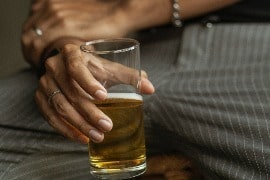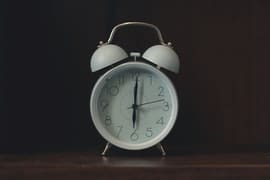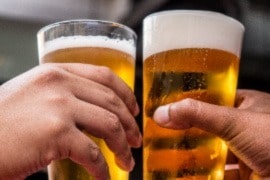NIAAA researchers found that there were five distinct patterns of alcohol dependence.
Although the word “alcoholic” may conjure a particular image to mind, there are actually several different types of alcoholics. Scientists at the National Institute on Alcohol Abuse and Alcoholism (NIAAA) surveyed 43,093 individuals, screening them for alcohol dependence as well as a wide range of other factors. Of that population, 1,484 met at least three criteria from the DSM-IV for alcohol dependence in the past year, which the researchers projected to represent approximately 8 million American adults in the general population. Among these people:
- 68% were male
- 71% were white
- 49% were never married
Multiple different reasons can spur someone to drink until they’ve become dependent on alcohol. We surveyed 2,136 American adults who either wanted to stop drinking alcohol or had already tried to (successfully or not).
Among those surveyed:
- 64.9% used alcohol to cope with stress (to relax, unwind, or deal with life)
- 43.5% used alcohol to cope with mental health symptoms like anxiety or depression
- 61.9% used alcohol recreationally or socially
- 38.1% used alcohol out of boredom
- 16.6% reported being physically dependent on alcohol
- 17.8% used alcohol as part of their daily routine (i.e., a drink with dinner)
The NIAAA researchers found that there were five distinct patterns of alcohol dependence.
Article at a Glance:
Young adult alcoholics are most likely to be male and not seek treatment.
Young antisocial alcoholics have a high rate of psychiatric disorders and other substance abuse.
Functional alcoholics are older and often have full-time jobs.
Intermediate familiar alcoholics are typically employed and have a close family member who’s an alcoholic too.
Chronic severe alcoholics are the rarest and most dangerous type.
1. Young Adult Subtype
The young adult subtype is the most prevalent subtype, making up 31.5% of people who are alcohol dependent. The average age of dependent young adults is almost 25 years old, and they first became dependent at an average age of around 20 years old. They tend to drink less frequently than people of other types (an average of 143 days a year). However, most of their drinking is binge drinking – they drink 5 or more drinks on 73% of their drinking days. On drinking days, the average maximum number of drinks is almost 14. This pattern of alcohol use is more likely to be hazardous than non-binging patterns.
Related Topic: Am I an alcoholic
Young adult alcohol dependents are 2.5 times more likely to be male than female. About 75% have never been married, 36.5% are still in school, and 54% work full time. Approximately 22% have a first- or second-degree family member who is also dependent on alcohol. Compared to other types of alcoholics, young adults are less likely to have psychiatric disorders or legal problems. Fewer than 1% of them have antisocial personality disorder. About 32% also smoke cigarettes, and 25% also use cannabis.
Only 8.7% of young adult alcohol dependents have ever sought treatment for their drinking problem. If they do choose to seek help, they tend to prefer 12-step programs over specialty treatment clinics or private professional practices.
According to the National Institute on Alcohol Abuse and Alcoholism, more than half of college students drink alcohol and almost 35% binge drink. Each year, among college students between the ages of 18 and 24:
- More than 1,500 die from alcohol-related accidental injuries.
- Over 690,000 students are assaulted by another student who has been drinking.
- More than 97,000 students are victims of alcohol-related date rape or sexual assault.
In our recent survey, respondents reported that:
- 10.1% had their first alcoholic drink at 11 years old or younger
- 37.5% had their first alcoholic drink between 12–17 years old
- 39.7% had their first alcoholic drink between 18–25 years old
- 12.6% had their first alcoholic drink at 26 years old or older
2. Young Antisocial Subtype
Young antisocial alcohol dependents make up 21.1% of alcoholics – 54% of them have antisocial personality disorder (ASPD). ASPD is characterized by at least three of the following DSM-5 diagnostic criteria:
- Recurring criminal activities
- Regular fights or assaults
- Lack of regard for the safety of others
- Lack of remorse
- Impulsiveness
- Deceitfulness
- Irresponsibility
They are also young (average age 26 years) and have the earliest age of onset of drinking (average is under 16 years old) and the earliest age of alcohol dependence (average of 18 years). Young antisocial alcoholics drank an average of 201 days in the last year, binge drinking (consuming five or more drinks) on an average of 80% of their drinking days. When they drink, their maximum number of drinks is 17, the highest of any subtype of alcoholic.
Of this type, about 76% are male and only 7.6% have received a college degree, although another 13.4% are still in school. Approximately 47% are employed full time. Family incomes average around $32,000, the lowest among the subtypes alongside the chronic severe subtype.
Over half of young antisocial alcoholics have a close family member who is also alcohol dependent. In addition, they also have high rates of psychiatric disorders:
- 37% have major depression (and 15% have had a major episode of depression during childhood)
- 33% have bipolar disorder
- 19% have obsessive-compulsive personality disorder
- 14% have social phobia
They also have high rates of substance abuse:
- 77% smoke cigarettes
- 66% meet the criteria for cannabis abuse/dependence
- 29% have cocaine use disorder
- 22% have opioid use disorder
- 8% meet the criteria for amphetamine abuse/dependence
Almost 35% of young antisocial alcoholics have sought help for their alcohol dependence problems. They tend to go to self-help groups, alcohol detox programs, specialty treatment programs, and private health care providers.
Drinking and ASPD make for a dangerous combination. People with ASPD are 21 times more likely to develop alcohol dependence in their lifetimes. Meanwhile, alcohol is more likely to increase aggressive behaviors in people with ASPD than in people without. This may be because alcohol interferes with executive functioning in the brain, which regulates and inhibits aggressive behavior. People with ASPD also show impaired executive functioning, which may make them particularly vulnerable to this effect.
3. Functional Subtype
Functional alcoholics make up 19.4% of alcohol-dependent individuals. This group tends to be older, with an average age of 41 years. They also have a later age of first drinking (average of 19 years) and a later onset of alcohol dependence at an average of 37 years. They tend to drink alcohol every other day, an average of 181 days per year, and they consume five or more drinks on 54% of those days. On drinking days, they tend to consume a maximum of 10 drinks.
Researchers found that about 62% of functional alcoholics work full-time, 3.6% are in school full-time, and 5% are retired. Nearly 26% have a college degree or higher, and the average household income is almost $60,000, the highest among any of the subtypes. Approximately 40% are female, and nearly 50% are married.
About 31% of functional alcoholics have a close family member who also has alcohol dependence. They have moderate rates of major depression (24%) and smoking cigarettes (43%), and low rates of anxiety disorders, other substance use disorders, and the lowest rates of having legal problems (fewer than 1%).
Only 17% of functional alcoholics have ever sought help for their alcohol dependence. Those who do tend to make use of 12-step programs and private health care professionals.
4. Intermediate Familial Subtype
Intermediate familial alcoholics make up 18.8% of all alcoholics. Nearly half of them have a close family member who is also an alcoholic. They have an average age of 38 years, began drinking at almost age 17, and developed alcohol dependence at an average age of 32 years. Intermediate familial alcoholics drink on an average of 172 days a year, consuming five or more drinks on 54% of those days with a maximum of 10 drinks.
Researchers found that they have the highest rates of employment among alcoholics, with 68% working full-time and an average family income of nearly $50,000 a year. Almost 20% have a college degree. About 64% are male, while around 38% are married and 21% are divorced.
Intermediate familial alcoholics have elevated rates of mental illness:
- 47% have major depression
- 22% have bipolar disorder
- 19% have obsessive-compulsive disorder
- 15% have a generalized anxiety disorder
- 5% have antisocial personality disorder
They also have higher rates of substance use/abuse:
- 57% smoke cigarettes
- 25% have cannabis use disorder
- 20% have cocaine use disorder
Almost 27% of intermediate familial alcohol dependents have sought help for their drinking problem. They tend to prefer self-help groups, detoxification programs, specialty treatment programs and individual private health care providers.
5. Chronic Severe Subtype
This is the rarest and most dangerous type of alcoholism, making up 9.2% of alcoholics. Chronic severe alcoholics average 38 years of age. They begin drinking around age 16 and develop alcohol dependence later, around 29 years of age. This group has the highest rates of drinking, consuming alcohol on an average of almost 248 days a year and binge drinking on 69% of them with a maximum of 15 drinks.
Researchers found that about 65% of chronic severe alcoholics are male. They also have the highest divorce rates, with 25.1% divorced, 8.6% separated and only 28.7% married. Only 9% have a college degree, and they also have the lowest employment rate. Only 43% of chronic severe alcoholics are employed full-time and 7.6% are unemployed or permanently disabled.
Chronic severe alcoholics have the highest rate of family members who also experience alcohol dependence at 77%.
They are most likely to have mental illnesses:
- 55% have depression
- 47% have antisocial personality disorder (the second-highest rate, after young antisocial alcoholics)
- 34% have bipolar disorder
- 26% have social phobia
- 25% have dysthymia
- 24% have generalized anxiety disorder
- 17% have panic disorder
Substance abuse is also common:
- 75% smoke cigarettes
- 58% have cannabis use disorder
- 39% have cocaine use disorder
- 24% have opioid use disorder
Chronic severe alcoholics experience the most pervasive symptoms:
- The highest rate of emergency room visits related to drinking of any subtype
- 94% drink larger/longer amounts than intended
- 92% drink despite experiencing problems from drinking, such as at work, school, in relationships or while driving
- 88% experience withdrawal symptoms
- 83% have repeatedly tried to reduce their drinking
- 64% spend significant time recovering from drinking
- 48% reduced meaningful activities, like hobbies or family time, because of alcohol
Almost 66% of chronic severe alcoholics have sought help for their alcoholism. They have the highest rates of attendance at self-help groups, detoxification programs and specialized rehabilitation programs, and the highest rates of treatment in inpatient programs. When seeking treatment, they tend to turn to social workers, psychologists, psychiatrists and private physicians.
Alcohol Treatment with Dr. Wandler
Getting Help for Alcoholism
If you find that the above descriptions resemble you or a loved one, you’re not alone. Fortunately, there is help. At The Recovery Village, we offer evidence-based treatment methods that can address every aspect of each client’s treatment needs. We want to guide you down the path to recovery – call today to learn more.
Articles Related to Alcoholism

Alcohol detox isn’t easy and not everyone can do it on their own. That is why alcohol detox and alcohol withdrawal treatment is administered by medical professionals.

Alcoholism takes many forms, and the stereotype doesn’t always hold true. So when do a few drinks with friends become a full-blown alcohol addiction? How do you know if you are an alcoholic?

While cirrhosis scars from excessive drinking are irreversible, quitting alcohol and leading a healthier lifestyle can help your liver heal from alcohol-related liver disease.

When detoxing, hydration is key. However, certain food groups also have benefits when it comes to helping with the discomfort of withdrawal symptoms and detoxification.

Detox from alcohol can begin within hours. Typically, alcohol withdrawal symptoms happen for heavier drinkers. Alcohol withdrawal can begin within hours of ending a drinking session.

Daily drinking can have serious consequences for a person’s health, both in the short- and long-term. Many of the effects of drinking every day can be reversed through early intervention.


Moss, Howard; Chen, Chiung; Yi, Hsiao-ye. “Subtypes of Alcohol Dependence in a Nati[…]presentative Sample.” Drug and Alcohol Dependence, 2007. Accessed November 8, 2019.
National Institute on Alcohol Abuse and Alcoholism. “Fall Semester—A Time for Parents To Di[…]of College Drinking.” December 2019. Accessed May 14, 2020.
Moeller, F. Gerard; Dougherty, Donald. “Antisocial Personality Disorder, Alcohol, and Aggression.” National Institute on Alcohol Abuse and Alcoholism, 1994. Accessed November 8, 2019.
Bell CC. “DSM-IV: Diagnostic and Statistical Manua[…]of Mental Disorders.” JAMA. September 14, 1994. Accessed on February 3, 2021.
Fisher KA, Hany M. “Antisocial Personality Disorder.” StatPearls [Internet]. Updated December 8, 2020. Accessed on February 3, 2021.
The Recovery Village aims to improve the quality of life for people struggling with substance use or mental health disorder with fact-based content about the nature of behavioral health conditions, treatment options and their related outcomes. We publish material that is researched, cited, edited and reviewed by licensed medical professionals. The information we provide is not intended to be a substitute for professional medical advice, diagnosis or treatment. It should not be used in place of the advice of your physician or other qualified healthcare providers.